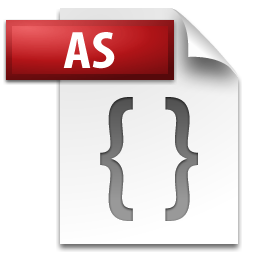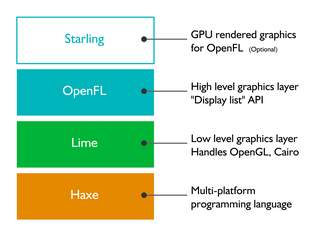
Adobe Flash is a multimedia software platform used for production of animations, rich internet applications, desktop applications, mobile apps, mobile games, and embedded web browser video players.
Bytecode is a form of instruction set designed for efficient execution by a software interpreter. Unlike human-readable source code, bytecodes are compact numeric codes, constants, and references that encode the result of compiler parsing and performing semantic analysis of things like type, scope, and nesting depths of program objects.

ActionScript is an object-oriented programming language originally developed by Macromedia Inc.. It is influenced by HyperTalk, the scripting language for HyperCard. It is now an implementation of ECMAScript, though it originally arose as a sibling, both being influenced by HyperTalk. ActionScript code is usually converted to byte-code format by a compiler.

LLVM is a set of compiler and toolchain technologies that can be used to develop a frontend for any programming language and a backend for any instruction set architecture. LLVM is designed around a language-independent intermediate representation (IR) that serves as a portable, high-level assembly language that can be optimized with a variety of transformations over multiple passes. The name LLVM originally stood for Low Level Virtual Machine, though the project has expanded and the name is no longer officially an initialism.

Apache Flex, formerly Adobe Flex, is a software development kit (SDK) for the development and deployment of cross-platform rich web applications based on the Adobe Flash platform. Initially developed by Macromedia and then acquired by Adobe Systems, Adobe donated Flex to the Apache Software Foundation in 2011 and it was promoted to a top-level project in December 2012.
Adobe Flash Player is computer software for viewing multimedia content, executing rich Internet applications, and streaming audio and video content created on the Adobe Flash platform. It can run from a web browser as a browser plug-in or independently on supported devices. Originally created by FutureWave under the name FutureSplash Player, it was renamed to Macromedia Flash Player after Macromedia acquired FutureWave in 1996. It was then developed and distributed by Adobe Systems as Flash Player after Adobe acquired Macromedia in 2005. It is currently developed and distributed by Zhongcheng for users in China, and by Harman International for enterprise users outside of China, in collaboration with Adobe.
MTASC is an ActionScript 2.0 compiler written in the OCaml programming language by the company Motion Twin. It is free software and can be used alone or with other tools like swfmill to produce SWF files, which contain interactive multimedia content playable with the Flash Player. MTASC is also much faster than the Adobe Flash ActionScript compiler.

Adobe AIR is a cross-platform runtime system currently developed by Harman International, in collaboration with Adobe Inc., for building desktop applications and mobile applications, programmed using Adobe Animate, ActionScript, and optionally Apache Flex. It was originally released in 2008. The runtime supports installable applications on Windows, macOS, and mobile operating systems, including Android, iOS, and BlackBerry Tablet OS.
Tamarin is a discontinued free software virtual machine with just-in-time compilation (JIT) support intended to implement the 4th edition of the ECMAScript (ES4) language standard. Tamarin source code originates from ActionScript Virtual Machine 2 (AVM2) developed by Adobe Systems, as introduced within Adobe Flash Player 9, which implements ActionScript 3 scripting language. ActionScript Virtual Machine 2 was donated as open-source to Mozilla Foundation on November 7, 2006, to develop Tamarin as a high-performance virtual machine, with the support from broad Mozilla community, to be used by Mozilla and Adobe Systems in the next generation of their JavaScript and ActionScript engines with the ultimate aim to unify the scripting languages across web browsers and Adobe Flash platform and ease the development of better performing rich web applications.

Box2D is a free open source 2-dimensional physics simulator engine written in C++ by Erin Catto and published under the MIT license. It has been used in Crayon Physics Deluxe, Limbo, Rolando, Incredibots, Angry Birds, Tiny Wings, Shovel Knight, Transformice, Happy Wheels, and many online Flash games, as well as iPhone, iPad and Android games using the Cocos2d or Moscrif game engine and Corona framework.

Adobe Flash Builder is an integrated development environment (IDE) built on the Eclipse platform that speeds development of rich Internet applications (RIAs) and cross-platform desktop applications, particularly for the Adobe AIR platform. Adobe Flash Builder 4 is available in two editions: Standard and Premium.
Google Native Client (NaCl) is a discontinued sandboxing technology for running either a subset of Intel x86, ARM, or MIPS native code, or a portable executable, in a sandbox. It allows safely running native code from a web browser, independent of the user operating system, allowing web apps to run at near-native speeds, which aligns with Google's plans for ChromeOS. It may also be used for securing browser plugins, and parts of other applications or full applications such as ZeroVM.

Away3D is an open-source platform for developing interactive 3D graphics for video games and applications, in Adobe Flash or HTML5. The platform consists of a 3D world editor, a 3D graphics engine, a 3D physics engine and a compressed 3D model file format (AWD).
Emscripten is an LLVM/Clang-based compiler that compiles C and C++ source code to WebAssembly, primarily for execution in web browsers.

GraalVM is a Java Development Kit (JDK), written in Java. The open-source distribution of GraalVM is based on OpenJDK, and the enterprise distribution is based on Oracle JDK. As well as just-in-time (JIT) compilation, GraalVM can compile a Java application ahead-of-time so that it starts instantly, provides peak performance with no warmup, and uses fewer resources. It provides additional programming languages and execution modes. The first production-ready release, GraalVM 19.0, was distributed in May 2019. The most recent release is GraalVM for JDK 21, made available in September 2023.

Flare3D is a framework for developing interactive three-dimensional (3D) graphics within Adobe Flash Player, Adobe Substance and Adobe AIR, written in ActionScript 3. Flare3D includes a 3D object editor and a 3D graphics engine for rendering 3D graphics. Flare3D runs on current web browsers utilizing the Adobe Flash Player, and uses Stage3D for GPU-accelerated rendering. Flare3D has not been under active development since late 2014.

Shumway is a discontinued media player for playing SWF files. It was intended as an open-source replacement for Adobe Flash Player. It is licensed under Apache and SIL Open Font License (OFL). Mozilla started development on it in 2012. It was preceded by a failed earlier project called Gordon, a JavaScript library with a similar concept and name, which interprets SWF files with onboard resources of a browser via SVG conversion. These names are an allusion to Flash Gordon and Gordon Shumway.
Stage3D is an Adobe Flash Player API for rendering interactive 3D graphics with GPU-acceleration, within Flash games and applications. Flash Player or AIR applications written in ActionScript 3 may use Stage3D to render 3D graphics, and such applications run natively on Windows, Mac OS X, Linux, Apple iOS and Google Android. Stage3D is similar in purpose and design to WebGL.

OpenFL is a free and open-source software framework and platform for the creation of multi-platform applications and video games. OpenFL applications can be written in Haxe, JavaScript, or TypeScript, and may be published as standalone applications for several targets including iOS, Android, HTML5, Windows, macOS, Linux, WebAssembly, Flash, AIR, PlayStation 4, PlayStation 3, PlayStation Vita, Xbox One, Wii U, TiVo, Raspberry Pi, and Node.js.








